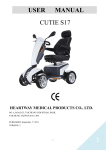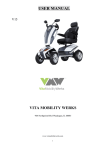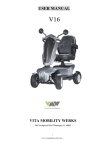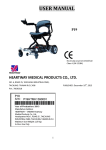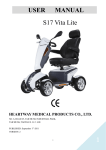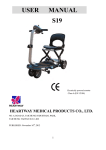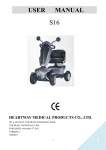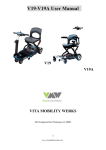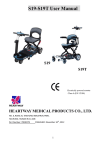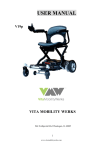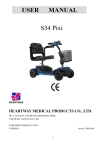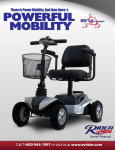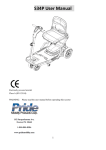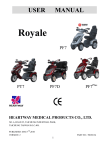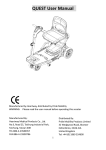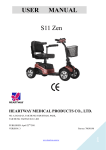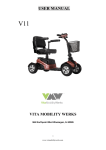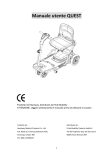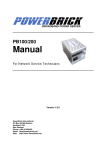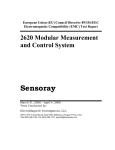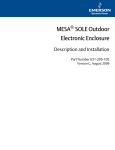Download USER MANUAL - Mobility Scooters Direct
Transcript
USER MANUAL PF6/ PF6K HEARTWAY MEDICAL PRODUCTS CO., LTD. NO. 6, ROAD 25, TAICHUNG INDUSTRIAL PARK, TAICHUNG. TAIWAN R.O.C.408 PUBLISHED: JUNE.21st , 2010 VERSION: 1 PART NO.: 70030059 . CONTENTS 1. SAFETY INSTRUCTION…………………………………...……………................................…1 2. ELECTOMAGNETIC INTERFERENCE(EMI)…………….…………………………………5 3. SPECIFICATIONS………………………….………………..…………….…………………..7 4. COMFORT ADJUSTMENT……………………….…………………………..………………..9 5. OPERATION OF CONTROL PANEL…………………………………………………………10 6. CHARGING INSTRUCTION….……………………………..………….……………………..13 7. BATTERY INSTRUCTION & MAINTENANCE…………...……………………….…..…15 8. SCOOTER MAINTENANCE & REPAIR…..…………...………………….………..……..…17 9. TROUBLESHOOTING & FAULT REPAIR……….………..…………………………………19 10. CIRCUIT DIAGRAM…….………..…….……..………………………..………………………21 11. BOM LIST DRAWING………………............…………………….………….…………………22 12. WARRANTY DECLARATION…………………………………………………………………23 SAFETY INSTRUCTION General Always use a seat belt, and keep your feet on the Never operate the scooter while you are under the scooter all the time. influence of alcohol. Never use electronic radio transmitters such as Make sure that there are no obstacles behind you while reserving your scooter. walkie-talkies, or cellular phones. Do not make a sharp turn or a sudden stop while Do not ride your scooter in traffic. riding your scooter. 1 Do not attempt to climb curbs greater than Do not leave your hands and legs off the scooter limitation show on Technical Specification when driving. Do not ride your scooter during snow in order to Do not allow unsupervised children to play near avoid accident on slippery road. this equipment while the batteries are charging. Warning – Don’t operate your scooter for the first time without completely reading and understanding this user manual. 1. 2. 3. 4. Don’t operate scooter on public streets and roadways. Be aware that it may be difficult for traffic to see you when you are seated on the scooter. Obey all local pedestrian traffic rules. Wait until your path is clear of traffic, and then proceed with extreme cautions. To prevent injury to yourself or others, always ensure that the power is switched off when getting on or off of the scooter. Always check that the drive wheels are engaged (drive mode) before driving. Do not switch off the power when the scooter is still moving forward. This will bring the chair to an extremely abrupt stop. Do not use this product or any available optional equipment without first completely reading and understanding these instructions. If you are unable to understand the warnings, cautions or instructions, contact a healthcare professional, the dealers or technical supports before attempting to use this equipment, otherwise, injury or damage may occur. 2 5. 6. 7. 8. 9. 10. 11. 12. 13. There are certain situations, including some medical conditions, where the scooter user will need to practice operating the scooter in the presence of a trained attendant. A trained attendant can be defined as a family member or care professional especially trained in assisting a scooter user in various daily living activities. Consult with your physician if you are taking any medication that may affect your ability to operate your scooter safely. Do not attempt to lift or move a power scooter by any of its removable parts including the armrests, seats or shrouds. Personal injury and damage to the power chair may result. Never try to use your scooter beyond its limitations as described in this manual. Please do not sit on your scooter while it is in a moving vehicle. Keep your hands away from the wheels (tires) while driving scooters. Be aware that loose fitting clothing can become caught in the drive tires. Consult your physician if you are taking prescribed medication or if you have any certain physical limitations. Some medications and limitations may impair your ability to operate scooters in a safe manner. Be aware when the drive mode is unlocked or locked. Don’t remove anti-tipper if there is any-tipper equipped with the scooter. Contact with tools can cause electrical shock and do not connect an extension cord to the AC/DC converter or the battery charger. 14. Do not attempt to lift or move your scooter by any of its removal parts, such as the armrests, seats, or shroud. 15. When climbing an incline, don’t drive at an angle up the face of the incline. Drive your scooter straight up the incline. This greatly reduces the possibility of a tip or a fall. 16. Don’t climb a slope steeper than the scooter’s limitation. 17. Don’t attempt to have your scooter proceed backward down any step, curb or other obstacle. This may cause the scooter to fall or tip. 18. Always reduce your speed and maintain a stable center of gravity when cornering sharply. Don’t corner sharply when driving scooters at higher speeds. 19. Operating in rain, snow, salt, mist conditions and on icy or slippery surfaces may have an adverse affect on the electrical system. 20. Never sit on your scooter when it is being used in connection with any type of lift or elevation product. Your scooter is not designed with such use in mind and any damage or injury incurred from such use is not the responsibility of Heartway. Modifications Heartway Medical Product has designed and engineered power scooters to provide maximum utility. However, under no circumstances should you modify, add, remove, or disable any part or function of your power scooter. Personal injury and damage to the power chair may result. 1. Do not modify your power scooter in any way not authorized by Heartway. Do not use accessories if they have not been tested or approved for Heartway products. 3 2. Get to know the feel of your power scooter and its capabilities. Heartway recommends that you perform a safety check before each use to make sure your scooter operates safely. Inspections prior to using your power scooter: 1. If equipped with pneumatic tires, please check for proper tire inflations. 2. Please check all electrical connections and make sure they are tight and not corroded. 3. Please check all harness connections and make sure they are secured properly. 4. Please check the brakes. Weight limitation. 1. Please refer to the specifications table for weight capacity information. Power scooter is rated for a maximum weight capacity. 2. Stay within the specified weight capacity for your scooter. Exceeding the weight capacity voids your warranty. Heartway will not be held responsible for injuries or property damage resulting from failure to observe weight limitations. 3. Don’t carry passengers on scooters. Carrying passengers on scooter may affect the center of gravity, resulting in a tip or a fall. Tire inflation 1. If your scooter is equipped with pneumatic tires, it is necessary to check the air pressure at least one time a week. 2. Proper inflation pressures will prolong the life your tires and ensure the smooth operation while riding. 3. Do not under-inflate or over-inflate your tires. It is critically important that 30-25 psi (2-2.4bar) tire pressure be maintained in pneumatic tires at all times. 4. Inflating your tires from an unregulated air source could over-inflate them, resulting in a burs tire. Temperature 1. Some of the parts of the power scooter are susceptible to change in temperature. The controller can only operate in temperature that ranges between -25℃ ~ 50℃. 2. At extreme low temperatures, the batteries may freeze, and your power scooter may not be able to operate. In extreme high temperatures, it may operate at slower speeds due to a safety feature of the controller that prevents damage to the motors and other electrical components. 4 ELECTROMAGNETIC INTERFERENCE (EMI) The rapid development of electronics, especially in the area of communications, has saturated our environment with electromagnetic (EM) radio waves that are emitted by television, radio and communication signals. These EM wave are invisible and their strength increases as one approach the source. All electrical conductors act as antennas to the EM signals and, to varying degrees, all power wheelchairs and scooters are susceptible to electromagnetic interference (EMI). The interference could result in abnormal, unintentional movement and/or erratic control of the vehicle. The United States Food and drug Administration (FDA) suggests that the following statement be incorporated to the user’s manual for all power scooter like the PF6 & PF6K. Power scooters may as susceptible to electromagnetic interference (EMI), which is interfering electromagnetic energy emitted from sources such as radio stations, TV stations, amateur radio (HAN) transmitter, two-way radios, cellular phones and alarm systems of shops. The interference (from radio wave sources) can cause the power scooter to release its brakes, move by itself or move in unintended directions. It can also permanently damage the powered scooter’s control system. The intensity of the EM energy can be measured in volts per meter (V/m).Each powered scooter can resist EMI up to a certain intensity. This is called “immunity level”. The higher the immunity level the greater the protection. At this time, current technology is capable of providing at least 20 V/m of immunity level, which would provide useful protection against common sources of radiated EMI. Following the warnings listed below should reduce the chance of unintended brake release or powered scooter movement that could result in serious injury: 1. Do not turn on hand-held personal communication devices such as citizens band (CB) radios and cellular phones while the powered scooter is turned on. 2. Be aware of nearby transmitters such as radio or TV stations and try to avoid coming close to them. 3. If unintended movement or brake release occurs, turn the powered scooter off as soon as it is safe. 4. Be aware that adding accessories or components, or modifying the powered scooter, may make it more susceptible to interference from radio wave sources (Note: It is difficult to evaluate the effect on the overall immunity of the powered scooter). Report all incidents of unintended movement or brake release to the powered scooter manufacturer, and note whether there is a radio wave source nearby. 5. 5 TURN OFF YOUR POWERED SCOOTER AS SOON AS POSSIBLE WHEN EXPERIENCING THE FOLLOWING: Unintentional scooter movements Unintended or uncontrollable direction. Unexpected brake release The FDA has written to the manufacturers of power scooters asking them to test new products to be sure they provide a reasonable degree of immunity against EMI. The FDA requires that a powered wheelchair should have an immunity level at least 20 V/m, which provides a reasonable degree of protection against more common sources of EMI. The higher the immunity level the greater the protection. Your powered scooter has an immunity level of 20 V/m which should protect against common sources of EMI. Warning: The scooter itself can disturb the performance of the electromagnetic fields such as emitted by alarm systems of shops. 6 PF6 - TECHNICAL SPECIFICATION 7 PF6K - TECHNICAL SPECIFICATION 8 COMFORT ADJUSTMENT Adjustments for Seating Comfort: Press the bottom to adjust the height of the headrest. The flip-up armrest height can be adjusted by turning the adjustment dial. Adjust the seat back lever for seating back angle. Turn the swivel lever downwards to rotate the seat. Push the front lever upwards to move the seat forward and backward. 9 OPERATION OF CONTROL PANEL The power scooter is simple to operate. However we recommend that you read carefully the following instructions to become familiarized with your new vehicle. Caution: Before you turn the power on, always be aware of the environment that surrounds you to select your desired speed. For indoor environments we recommend that you select the slowest speed setting. For outdoor operation of this vehicle we recommend that you select a speed that is comfortable for you to control it safely. The following steps are required to operate your vehicle safely with the controller Battery Indicator Speed Adjuster Power ON/OFF Light I / O Button Key Headlight Hazard Light Left Signal Light Right Signal Light Horn Button functions 1. Battery Indicator: When your scooter is switched on, the needles on the meter will move across the scale from the left 'red' sector towards the 'green' sector, indicating the state of charge in your batteries. As the power is used up in your batteries the needle will move towards the 'red' sector indicating the state of charge at that precise time. When the needle is fully over to the right, the batteries are fully charged. When the needle falls towards the red sector your batteries are losing power, but you will still have power to spare. When the needle falls into the red sector your batteries are low in power and need to be recharged. It is wise to recharge your batteries when the needle enters the red zone (see Batteries and Battery Charging section of this manual). 10 2. Manual Speed Adjuster: This allows you to pre-select your desired speed. The adjuster is proportional to speed and can be set anywhere between green for low speed to red for high speed. Turn the adjuster knob counter-clockwise to minimum for a very gentle operation, and clockwise towards maximum to increase your speed. 3. Power ON/OFF Light: The light will turn on if you insert into the key. The light will turn off if you take out of the key. 4. Headlight Switch Button: Press once to turn on the headlight. Press again to turn the headlight off. 5. Hazard Lights Switch Button: Press once to turn hazard lights on, both right / left front and back signal lights will flash once per second, and horn will beep once per second, press again to turn hazard lights off. 6. Left Signal Lights Switch Button: Press once to turn left signal lights on. (Both left front and back signal lights will flash once per second, horn will beep once per second, press again to turn left signal lights off.) 7. Right Signal Lights Switch Button: Press once to turn right signal lights on. (Both right front and back signal lights will flash once per second, horn will beep once per second, press again to turn right signal light off.) 8. Horn button: Press this button to sound the horn.( Easy operation for left hand or right hand) 11 Driving: Controller ON/OFF Switch 1. Insert the key to turn the scooter power on (Turn the power off and remove the key). Push the finger lever control forward or backward to control the driving direction of the vehicle. Wig-wag KEY (Fig 11) (Fig 12) Returning of the finger lever control to its neutral position(center), will reduce the speed and stop the vehicle by automatically applying the electromagnetic brakes. 2. Speed Control: Press “I / O “ button (H/L gear mode): Automatically change H gear to L gear or from L to H gear. (Press O on H gear, press I on L gear) Turn the speed adjuster knob clockwise towards maximum to increase your speed, and counter-clockwise toward minimum to slow down your speed. Wig-wag Controlling. The wig wag lever control also controls the speed of your vehicle. The further away (forward/ backward) the finger lever control is from the neutral position, the faster the vehicle will go. Notes: →After inserting the key into controller ON/OFF port, the light of power ON/OFF will turn on for a few seconds during self checking process. →In case of emergency, let go of the finger lever control and the vehicle will come to a stop. 12 CHARGING INTRUCTIONS 1. SPECIFICATION Item BATTERY CHARGER (SWITCHING MODE) Model 4C24050A Output Current(DC) 5A±5% Charging Voltage(DC) 28.8V Floating Voltage(DC) 27.6V Input Current (AC) 2A max. Input Voltage(AC) 100 ~ 240 V Efficiency 50/60Hz AC-DC 85% min Operating Temperature 0°C ~ 40°C Switching Method SWITCHING MODE Charging Method Battery Application Constant current two stage constant voltage Output Detection 24V Lead Acid Rechargeable Battery (20Ahr ~ 60Ahr) 1.Short Circuit Protection 2.Reverse Power Protection 3.Overheat Protection 4.Charging Plug Protection Operating Humidity 20% ~ 85 % Measure L 177mm×W 118mm×H 68mm Weight 1.2K g Color Black 2. OPERATING INSTRUCTION (1)Make sure the battery charger output voltage is the same as the connecting battery. (2)Plug in the power cord. LED indicates red & green flash when AC power on. (3)Connect the battery charger to the battery. (4)Start charging; please refer to 4. LED INDICATION 3. LED INDICATION (1)Green Flash:Wait for connection of Battery (2)Orange Flash:Pre-Charge (3)Orange :Charging (4)Green & Orange Flash:Charged 85% (5)Green:Full charged (6)Red Flash:Defect 13 4. TROUBLE SHOOTING (1) If green indicator is off: ․Check AC input. If it works functionally, the battery charger may be defective. (2) If green indicator keeps flashing and cannot turn to charging indication: ․Check if the battery connector is connected successfully. ․Check if there is any short circuit on the output connection. ․The battery charger may be defective if the battery connection works functionally. (3) If red indicator keeps flashing : ․Check if the battery connection is reversed. ․Check if there is any short circuit on the output connection. ․Check if the environment temperature is too low (0oC) ․The battery charger may be defective if the red indicator still keeps flashing. (4) Charging indicator (orange) cannot turn to green: ․The battery might be defective, please stop charging and have the battery be repaired. (5) If the charging indicator (orange) turns to green (fully charged) immediately: ․The battery may be in well-charged condition. ․The battery may be defective if the battery is not fully charged. 14 6. CAUTION (1) Before using the battery charger, read all instructions and cautionary markings. (2) Use the battery charger in a well-ventilated area (3) To avoid the risk of injury, charge only lead-acid or gel cell type rechargeable batteries. (4) Please turn off the power after charging Important! Always charge your batteries in well ventilated areas. The charger is intended for indoor use only. Please protect it from the moisture. For maximum performance, it is recommended that you replace both batteries at the same time if the batteries are weak. If the scooter will not be used for a long period of time, arrange to have the batteries recharge at least once every month to avoid deterioration of the batteries. 15 BATTERY INSTRUCTION & MAINTENANCE Read through the charger operating instruction before using it. Make sure you charge the battery every time after you use the power chair or scooter. Charge the battery at least 24 hours a week if the power chair or scooter has not been used. (This is to make sure that the electrolyte is always at the top level) If the battery cannot be charged (Orange light cannot turn to Green) or if the Orange light turns to Green immediately, please check it with the technicians. The battery may be defective. The voltage difference between the two batteries on a power unit cannot be more than 0.5 V; the battery case should be inspected for cleanliness and evidence of damage. If the charger indicates red light, please kindly check if the charger is defected or if the cable wiring connection is poor. Please keep the battery and ⊕connectors clean otherwise the charging condition will be poor. 16 SCOOTER MAINTENANCE & REPAIR Your power scooter is designed for minimal maintenance. However, like any motorized vehicle it requires routine maintenance. To keep your scooter for years of trouble-free operation, we recommend you follow the following maintenance checks as scheduled. DAILY CHECKS 1. Visual check on the conditions of tires. 2. Inspect the battery condition meter on the controller to determine if batteries need to be charged. WEEKLY CHECKS 1. Your power scooter comes with standard pneumatic tires. If your power scooter comes with optional air tires, make sure to maintain the pressure of the tires between 30-35 psi. MONTHLY CHECKS 1. Visually inspect the controller harnesses. Make sure that they are not frayed, cut or have any exposed wires. SEMI-ANNUAL CHECKS 1. Check the motor brushes. We recommended that your authorized dealer inspect the brushes every six months or sooner if your power scooter is not operating smoothly. If inspection determines excessive wear on the brushes, they must be replaced or motor damage will result. 17 Warning! Failure to maintain the brushes could void the power scooter warranty. To inspect or replace the motor brushes: 1. Unscrew the motor brush caps. 2. Remove the brushes. Less than 9 mm 3. Inspect the brushes for wear. 4. Replace the brushes if necessary. New Motor Brush Worn Motor Brush Motor Brush caps Inspect the state of the battery terminals every six months. Make sure that they are not corroded and the connections are tight. Periodically apply a thin film of petroleum jelly on the surface of terminals to guard against corrosion. CHECKS: Make sure to keep the controller clean while protecting it from rain or water. Never hose off your power scooter or place it in direct contact with water. Keep wheels free from lint, hair, sand and carpet fibers. Visually inspect the tire tread. If less than 1mm (1/32”), please have your tires replaced by your local dealer. All upholstery can be washed with warm water and mild soap. Occasionally check the seat and back for sagging, cuts and tears. Replace if necessary. Do not store your scooter in damp or humid conditions as this will lead to mildew and rapid deterioration of the upholstery parts. All moving mechanism will benefit from simple lubrication and inspection. Lubricate using petroleum jelly or light oil. Do not use too much oil, otherwise small drips could stain and damage carpets and furnishings etc. Always perform a general inspection of the tightness of all nuts and bolts. 18 TROUBLESHOOTING & FAULT REPAIR RHINO controller: Your scooter is fitted with a Rhino controller, which continuously monitors the operating conditions of your scooter. If it detects a problem it will indicate with error message by flashing light on the power ON/ OFF light. You must count the number of the flash, and see the list to check what kind of error has happened according to the number) Number of Fault Flashes 1 Impact on Notes Scooter Battery needs Will drive Battery charge is running low. Recharge the batteries recharging 2 as soon as possible. Battery Drive Battery charge is empty. Recharge the batteries. If the voltage too inhibited scooter is left off for a few minutes, battery charge low may recover sufficiently to allow driving for a short period of time. 3 Battery Drive Battery charge is too high. If a charger is plugged in, voltage too inhibited unplug it or turn the Charge/Run switch to Run. high Scooters powered by RHINO will charge the batteries when traveling down slopes or decelerating. Excessive charging in this manner may cause this fault. Turn the scooter power off and then back on again. 4 Current limit Drive The scooter has drawn too much current for too long, time out inhibited possibly because the motor has been over worked, jammed or stalled. Turn the scooter power off, leave for a few minutes, and then turn the power back on again. The controller has detected a shorted motor. Check the loom for shorts and check the motor. Contact your service agent. 5 Brake fault Drive Check that the park brake release lever is in the inhibited engaged position. The park brake coil or wiring is faulty. Check the park brake and wiring for open or short circuits. Contact your service agent. 6 Out of Neutral Drive Throttle is not in neutral position when tuning switch 19 at Power Up inhibited key on. Return throttle to neutral, turn power off and back on again. Throttle may need to be re-calibrated Check throttle wiring. 7 Speed Pot Drive The throttle or its wiring is faulty. Check for open or Error inhibited short circuits. Throttle may not be correctly set up. Contact your service agent. 8 Motor Volts Drive The motor or its wiring is faulty. Check for open or Error inhibited short circuits. Contact your service agent. 9 10 Other Internal Drive Contact your service agent. Errors inhibited Push Too Fast Drive The scooter has been pushed faster than the fault inhibited programmed "Push Speed' parameter when the Park Brake Release function has been operated. The scooter has been pushed faster than the programmed "Rollaway Speed" parameter when the Park Brake has been mechanically released. Turn the scooter off and then back on again. Note: If you experience any technical problems, it is recommended that you check with your local dealer before attempting to troubleshoot on your own. The following symptoms could indicate a serious problem with your power scooter. Contact your local dealer if any of the following arises: 1. Motor noise 2. Frayed harnesses 3. Cracked or broken connectors 4. Uneven wear on any of tires 5. Jerky motion 6. Pulling to one side 7. Bent or broken wheel assemblies 8. Does not power up 9. Powers up, but does not move 20 CIRCUIT DIAGRAM 21 BOM LIST DRAWING 22 WARRANTY DECLARATION Quality/ Warranty Declaration Products are to be fit for purpose and of excellent quality and performance. For valid warranty claims Heartway will, at their discretion, replace/ repair/ refund items mutually agreed to be defective. Heartway’s Warranty as Following: Frame: Two-year limited warranty Controllers: One-and-a-half-year limited warranty Electronic Components and Charger: One-year limited warranty Warranty Exclusion. The following items are not covered by warranty. Motor brushes Wheel Tires Arm Pads Seat Cushion Fuses / Bulbs Tiller Cover Rear Shroud Front Shroud Batteries and Consumable parts Any damage or defect of any nature occurring from the misuse, abuse of the product, improper operation or improper storage is not to be covered. The warranty is to start from the date of arrival of our products. HEARTWAY MEDICAL PRODUCTS CO., LTD. NO. 6, ROAD 25, TAICHUNG INDUSTRIAL PARK, TAICHUNG. TAIWAN R.O.C.408 23

























